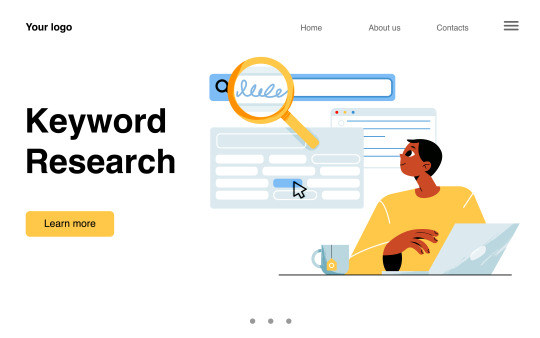#tips-keywords
Explore tagged Tumblr posts
Note
Do you know a good source for 50s or 60s hairstyles refs for women I keep typing black women 1950s hairstyles into Google and I get absolutely nothing and it's killing me
I have a few!
Ebony magazine has an archive, though unfortunately it only covers the very very late 50s and 60s. Still, an excellent resource. This is from Feb 1960.


The Internet Archive is also a fantastic resource for magazines. If you need specific places to start, you can loan these, though you do need an account (but if you're referencing vintage hair and fashion I suspect you already have one ;3c)


Youtube is a pretty good reference for hair, with the caveat that sometimes i come across a hair or makeup video that isn't necessarily totally accurate and more along the lines of a 2020s interpretation of 50s/60s fashion. How much that matters is more of a taste thing, but it never hurts to be aware. I did find this, so i hope that helps you out a little.
youtube
#text post#i clicked into her channel and it's a great resource#there are period dramas set in that time too but the same problem can crop up of it not necessarily being suuuuuuper accurate#a good tip when looking for vintage stuff is by nature it's not going to be tagged with the same keywords something made today would be#by merit of things being in print/movies/stills etc etc#if you find yourself struggling for a specific resource try and zoom out a little#hope these help
27 notes
·
View notes
Text
HOW TO READ TEXTBOOKS/PAPERS/ETC. FOR HOT ADHD BITCHES*
*the hot adhd bitches in question are me and my alters. obligatory "your mileage may vary" disclaimer. this is also tailored to scientific papers rather than, say, fictional literature
it took me six fucking years of being in college to figure this out somehow. i think it's either the adhd meds or the "plant medicine" that helped. i'm not saying this'll work for everyone, i just wanted to share my own personal tips in case anyone else might get some use out of them! C:
get comfortable. block out a good chunk of time to focus on this.
skim the paper. get a general idea of what it's about.
now here's where the fun part begins. add whitespace to the side of the paper to add annotations, using your preferred method. whether it be using a PDF editor or putting sticky notes on the book
go back to the introduction (if there is one). where it summarizes the main points of the paper. now, turn each of these main points into a question. for example if it says "This paper discusses the primary causes of climate change," you can write next to the introduction in the whitespace you just created, "What are the primary causes of climate change?" or (if the introduction lists the specific causes) "How do greenhouse gas emissions cause global warming?" make sure to leave some space below each question, because you will be going back and answering these keep these questions in mind during the next few steps!
one at a time, read each paragraph fully and in the whitespace next to it, summarize it in 1 or 2 sentences. if it's already only 1 or 2 sentences, rephrase it in your own words. the summary can be as nonacademic-sounding as you want, whatever best helps you understand and absorb the main point of the paragraph.
also write down any questions that come up while reading that you'd wanna ask the instructor or other expert
make sure to take breaks, but not for too long. if you don't know if the pomodoro technique works for you or not, i highly recommend trying it at least once and possibly adjusting it to your preferences
once you've gone through and summarized every paragraph (at whatever pace you need to do it effectively), NOW you go back and answer all the questions you set up in the introduction! your answers will probably end up being summaries of your summaries, thus encouraging you to go back and properly comprehend what you've written
read ALL your notes one more time to make sure you understand everything, and can ideally explain the main points of the paper in your own words if asked
and you're done! hooray! give yourself a little treat
#life tips#highlighting shit never worked for me personally#id focus more on finding shiny and important-looking keywords than actually comprehending the text
7 notes
·
View notes
Text
Worldbuilding Tips: How to Find Inspiration

Picture this. You’re minding your own business when out of nowhere you’re struck with creative genius. This new story idea consumes your every waking thought, playing out like a brilliant movie inside your head. However, when you try to put pen to paper (or fingers to keyboard), words fail you. It’s a dilemma all writers face in their career. How do you turn an idea into reality? Don’t fight it. Explore it.
Fun Fact: There’s no right or wrong place to begin building your fictional world. You define your creation journey. The trick is finding what works best for you specifically.
Are you more visual? Pinterest is a great source of inspiration. Keyword searches are your friend. What is a keyword? It’s a “significant word from a title or document used especially as an index to content.” Type in a word(s) into the search bar that summarizes the aesthetic you’re visualizing and let the magic happen. This could be anything from a color, time period, genre, trope, etc. Take one of my own creations, Scavenge Clan, for example. Keywords I associate with it include: hyena, werehyena, bones, gothic, scavenger, vulture culture, vultures, black-haired women, death. Over time, your searches will affect your algorithm, giving you more ideas that line up with your stories in the long run.
Are you more auditory? Creating Spotify playlists that remind you of your story and/or characters can help give you more inspiration and set the mood for when you start writing.
Are you both visual and auditory? I love collecting fan made tribute videos on YouTube of TV shows and movies that give me a source of inspiration for my stories. For example, the TV show Grimm with a splash of the grounders from The 100 inspired my main story universe The Culling Wars.
Wherever you draw inspiration from, take advantage of it. Use it to expand your ideas and to help you when you’re feeling stuck. Remember that every bestselling novel started as a mere idea.
#writeblr#writers of tumblr#writing#writing community#creative writing#worldbuilding#worldbuilding tips#writing tips#writing inspiration#keywords#pinterest#spotify#youtube#writing music
60 notes
·
View notes
Text
the little tarot shop I like runs an eight week self-study tarot course (tho u can do it at your own pace) and it sounds cool and I'm thinking about signing up but I'm Nerbous
#hmmmmmmmb#its less abt learning specific meanings and keywords and such and more about like#intuition and learning how to read cards together as a story and such#i think it might have some good tips#I'm still a beginner even tho I've vaguely been reading for almost ten years LMAO
19 notes
·
View notes
Text

Keyword Skills to Be Noted in the Resume to Catch the Eye of Recruiters.
Skills for resume are terms particular abilities searched for mostly by the recruiters, though it could include technical skills, soft skills, or certifications. By inserting these keyword skills into your resume, you ensure that you are included in relevant job searches and able to pass candidate screening tests easily.
Read More: https://www.mployee.me/blog/find-out-why-using-right-keywords-for-you-cv-matters
2 notes
·
View notes
Text
How to Build Your Brand Using Instagram and Facebook

Building a strong brand is important for standing out in today’s competitive world. Instagram and Facebook are powerful tools that can help you connect with your audience and grow your business. Here’s a simple guide to building your brand using these platforms:
1. Understand Your Brand
• Start by knowing what your brand is about. What are your values, mission, and goals? Use these ideas to shape your message and design. Make sure your logo, colors, and tone are consistent across Instagram and Facebook.
2. Know Your Audience
• Find out who you want to reach. Are they young adults, parents, or professionals? Knowing your audience helps you create content they will love. Think about their interests, needs, and problems.
3. Post Great Content
Share eye-catching photos, videos, and graphics. Show behind-the-scenes moments, customer stories, or tips related to your business. For example:
Use Instagram Stories and Reels for fun, quick updates.
Post longer videos or articles on Facebook.
The goal is to make people enjoy your posts and remember your brand.

4. Be Consistent
• Create a schedule for posting. Consistency builds trust. For example, post 3 times a week on both platforms. Use tools like Facebook Creator Studio or Instagram Scheduler to plan ahead.
5. Use Hashtags and Keywords
• Add hashtags to your posts to make them easier to find. For example, if you’re a bakery, use hashtags like #FreshBread or #SweetTreats. Facebook works well with keywords and groups for better visibility.
See content credentialsGrow your brand in Facebook and Instagram with semarketing team
6. Engage With Your Followers
• Reply to comments and messages. Like and share posts where your brand is mentioned. When people feel valued, they become loyal fans.
7. Run Ads and Promotions
• Instagram and Facebook ads can help you reach more people. You can choose who sees your ads based on age, location, or interests. Run contests or special discounts to get people excited.
8. Partner With Influencers
• Work with influencers who share your values. They can introduce your brand to their followers, boosting your visibility and trust.
9. Analyze Your Results
• Use Instagram Insights and Facebook Analytics to see what works. Pay attention to likes, comments, and shares. Adjust your strategy based on the data.
10. Add Clear Call-to-Actions (CTAs)
Tell your audience what to do next. Examples of CTAs include:
“Follow us for more tips!”
“Click the link in our bio to shop.”
“Message us for details.”
Final Thoughts
• Building your brand takes time, but with consistent effort, Instagram and Facebook can help you grow. Share content that reflects your brand, engage with your audience, and always look for ways to improve.
Start today and watch your brand shine!
@nilkanthmistry
Write by : #nilkanthmistry
instagram : https://www.instagram.com/nilkanth.mistry/
facebook :https://www.facebook.com/nilkanth.mistry.52
linkdin : https://www.linkedin.com/in/nilkanth-mistry-78bb30272/
hashnode : https://hashnode.com/@Nilkanth?fbclid=IwY2xjawHgdiFleHRuA2FlbQIxMAABHTPsVmLarASxBLO_559tdXBVCbHdLWgt4gQoICViOHtwlVCohGrFMalaNQ_aem_8YWi51bEONuens5H3iFDKg
#digitalmarketing agency#digital marketing#social media#social media marketing#onlinebusiness#onlinemarketing#marketing#internationalmarketing#SEO#tips#Intenationlseo#Digitalmarketing#offpageseo#tipsofseo#onpageseo#importexport#keyword#websitedesign#hastag:#contentmarketing#marketingstrategy#facebook ads#facebook marketing
4 notes
·
View notes
Text
The Cups Suit in Tarot: The Depths of Emotion and Intuition 🌛 🌜
The Cups suit in tarot is a realm of emotions, relationships, and the heart. It provides insights into our feelings and the complexities of our emotions. From new beginnings symbolized by the Ace of Cups to the fulfillment of the Ten of Cups, the suit navigates the transformative power of emotions on our journey of self-discovery.
Keywords, Numerological Meaning & Zodiac sign associations
The Cups suit is linked to the water signs of Pisces, Cancer, and Scorpio, infusing the cards with unique qualities from these signs.
Ace of Cups
Symbolic Sentence: "Embrace the wellspring of emotion." Numerological Meaning: New beginnings, potential, opportunity. Astrological Correspondence: Moon in Pisces.
Two of Cups
Symbolic Sentence: "Harmony and unity bind two hearts." Numerological Meaning: Balance, partnership, harmony. Astrological Correspondence: Venus in Cancer.
Three of Cups
Symbolic Sentence: "Joyous gatherings celebrate connections." Numerological Meaning: Celebration, social connections, creativity. Astrological Correspondence: Mercury in Cancer.
Four of Cups
Symbolic Sentence: "Introspection leads to emotional clarity." Numerological Meaning: Contemplation, introspection, reassessment. Astrological Correspondence: Moon in Cancer.
Five of Cups
Symbolic Sentence: "Grief transforms into growth." Numerological Meaning: Loss, grief, emotional turmoil. Astrological Correspondence: Mars in Scorpio.
Six of Cups
Symbolic Sentence: "Nostalgia and innocence inspire happiness." Numerological Meaning: Nostalgia, memories, innocence. Astrological Correspondence: Sun in Scorpio.
Seven of Cups
Symbolic Sentence: "Dreams and illusions cloud judgment." Numerological Meaning: Choices, fantasies, illusion. Astrological Correspondence: Venus in Scorpio.
Eight of Cups
Symbolic Sentence: "Follow the soul's call to new horizons." Numerological Meaning: Transition, moving on, spiritual growth. Astrological Correspondence: Saturn in Pisces.
Nine of Cups
Symbolic Sentence: "Emotional satisfaction fills the heart." Numerological Meaning: Contentment, fulfillment, emotional satisfaction. Astrological Correspondence: Jupiter in Pisces.
Ten of Cups
Symbolic Sentence: "Harmony and emotional wholeness in family." Numerological Meaning: Harmony, happiness, family bonds. Astrological Correspondence: Mars in Pisces.
The court cards
The Page, Knight, Queen, and King of Cups serve as guides and mentors on the emotional path, offering unique strengths and insights to navigate feelings and relationships.
The Page of Cups: This card represents youthful energy, creativity, and emotional exploration. It often signifies a new phase in emotional development or the emergence of creative and intuitive abilities.
Knight of Cups: The Knight of Cups is a dynamic and passionate force within the Cups suit, embodying the spirit of emotional pursuit and the drive to actualize heartfelt desires. It encourages action in matters of the heart.
Queen of Cups: The Queen of Cups exudes nurturing support, deep compassion, and intuitive wisdom. She signifies emotional maturity and the capacity to hold space for others in a profoundly compassionate way.
King of Cups: The King of Cups embodies the pinnacle of emotional strength, stability, and leadership within the Cups suit. He represents emotional mastery, inner peace, and control over the turbulent waters of the heart.
Read the full article here:
#cups suit in tarot#minor arcana#tarot cards#tarot meanings#tarot keywords#tarot witch#divination#tarot lessons#tarot tips#cups suit
24 notes
·
View notes
Text
How to write a high-ranking travel blog?
I just realized something—I love writing about travel. Maybe it's because I don’t get to travel as much as I want, but deep-diving into destinations, cultures, and hidden gems? That’s my jam.
Lazy writers just throw in words like exquisite dining and culinary delights (ugh). I dig deeper—Reddit, Quora, local blogs—because good travel writing feels like a journey, not just a list of fancy adjectives.
Oh, and if you're writing about a luxury destination? Find what makes it stand out, not just how it looks. Add your voice, your style, and relevant keywords to make it rank better.
#seo#content writing#search engine optimization#seo tips#blogging#blog post#travel#blog#writing#keyword research
3 notes
·
View notes
Text
The Relevance of Conducting Keyword Research in Digital Marketing
In a world dominated by technology where businesses require visibility to succeed. The only way to cut through the noise of millions of websites is to know what your audience wants, and then create content that addresses that need. This is where conducting keyword research comes in- it is a critical building block that goes into constructing a good digital marketing strategy.
Understanding Keyword Research :
In most cases, users do not type in full sentences into search engines- instead, they search for keywords and phrases. Keywords are what connect the questions asked by the user, to a piece of content prepared to answer the query. Identifying keywords allows businesses to create content that users are looking for, increasing their chances of ranking higher in search results, and making more sales.

Why Is Keyword Research Important?
A Better Return On Investment (ROI): Returning from targeted ads is higher than any other form or investing in advertising channels, for example: Pay per click adverts.
Increased Visibility: It is extremely hard to get noticed as a new website, and investing in keywords will allow you to boost your website’s organic traffic.
Understanding Audience Intent: Good keyword research helps you understand what your target audience is looking for and how they phrase their queries. You can, therefore, create content that directly answers their needs, thus building trust and fostering engagement.
3. Competitive Advantage: Analyze the keywords your competitors are targeting, find gaps in their strategy, and identify opportunities to differentiate your content. This way, you are ahead in a crowded marketplace.
4. Cost-Efficient Advertising: Keyword research for paid campaigns is very important. For example, Google Ads has to be able to select appropriate cost-effective, high-performing keywords. So, targeting the right keywords really minimizes waste and maximizes ROI.
5. Content Strategy Development: It acts as a roadmap for content strategy. By creating blog posts, videos, and other such assets that actually resonate with the audience while satisfying the search engines, it provides a well-researched list of keywords.
Effective Keyword Research Tips
Use Tools: Utilize Google Keyword Planner, SEMrush, or Ahrefs to uncover the volume, competition, and trend of your keyword.
Long Tail Keywords: Be more specific as they tend to have less competition and more chances of conversion
Search Intent: Identify if it is an information intent, a navigational intent, or transactional intent to use it appropriately for your content.
Keep fresh: trends in searches change, and your keyword approach should be reviewed regularly.
Keyword research is far from a technical task; it's a strategic initiative that bestows business the power to connect with audiences more effectively. The time and resources you invest in understanding the language of your customers set you up for long-term digital marketing success. Whether you are optimizing for organic search or planning a PPC campaign, keyword research is the compass guiding your efforts toward measurable results.
#Digital Marketing#SEO Strategy#Search Engine Optimization#Audience Intent#Content Marketing#PPC Campaigns#Long-Tail Keywords#Marketing Tips#Competitive Analysis#Online Advertising#Marketing Strategy#Website Traffic#Organic Search#Digital Marketing Trends#Keyword research#keyword research tools
2 notes
·
View notes
Text
What is robots.txt and what is it used for?
Robots.txt is a text file that website owners create to instruct web robots (also known as web crawlers or spiders) how to crawl pages on their website. It is a part of the Robots Exclusion Protocol (REP), which is a standard used by websites to communicate with web crawlers.
The robots.txt file typically resides in the root directory of a website and contains directives that specify which parts of the website should not be accessed by web crawlers. These directives can include instructions to allow or disallow crawling of specific directories, pages, or types of content.
Webmasters use robots.txt for various purposes, including:
Controlling Access: Website owners can use robots.txt to control which parts of their site are accessible to search engine crawlers. For example, they may want to prevent crawlers from indexing certain pages or directories that contain sensitive information or duplicate content.
Crawl Efficiency: By specifying which pages or directories should not be crawled, webmasters can help search engines focus their crawling efforts on the most important and relevant content on the site. This can improve crawl efficiency and ensure that search engines index the most valuable content.
Preserving Bandwidth: Crawlers consume server resources and bandwidth when accessing a website. By restricting access to certain parts of the site, webmasters can reduce the load on their servers and conserve bandwidth.
Privacy: Robots.txt can be used to prevent search engines from indexing pages that contain private or confidential information that should not be made publicly accessible.
It's important to note that while robots.txt can effectively instruct compliant web crawlers, it does not serve as a security measure. Malicious bots or those that do not adhere to the Robots Exclusion Protocol may still access content prohibited by the robots.txt file. Therefore, sensitive or confidential information should not solely rely on robots.txt for protection.
Click here for best technical SEO service
#technicalseo#seo#seo services#robots.txt#404error#digital marketing#keyword research#keyword ranking#seo tips#search engine marketing#404 error#googleadsense#rohan
9 notes
·
View notes
Text
How to Create Designs That Work for Your Print-on-Demand Business
Running a print-on-demand business is both exciting and challenging. Whether you're selling on platforms like Redbubble or managing your own store, creating designs that resonate with your audience is the key to success. But how do you craft designs that not only look great but also sell? In this blog post, I’ll guide you through the process of creating designs that work for your print-on-demand business, with tips and tricks tailored to help you stand out in a competitive market. Let’s dive in!
Why Design Matters in Print-on-Demand
In the world of print-on-demand, your designs are your product. Unlike traditional retail, you’re not selling physical inventory—you’re selling ideas. Your customers are drawn to your creativity, so your designs need to:
- Capture attention: Bold, unique designs stand out in search results.
- Resonate with your audience: People buy designs that align with their personality, values, or interests.
- Fit the product: A design that looks great on a t-shirt might not work on a mug or phone case.
Understanding these principles is the first step to creating designs that work for your business.
Step 1: Know Your Niche
The most successful print-on-demand businesses are niche-focused. Instead of trying to appeal to everyone, target a specific audience.
- Research your audience: Who are they? What are their interests, hobbies, or values?
- Find trending niches: Use tools like Google Trends or Redbubble’s trending searches to discover what’s popular.
- Create for your passion: If you’re passionate about your niche, it will show in your designs.
For example, if your niche is cozy, minimalist designs, you could create products that appeal to people who love hygge-inspired aesthetics.
Step 2: Brainstorm Unique Design Ideas
Once you’ve identified your niche, it’s time to brainstorm ideas. Here’s how to get started:
- Use keyword research: Tools like Redbubble’s search bar or Pinterest Trends can help you find popular themes.
- Look for inspiration: Check out competitors, social media, or even nature for fresh ideas.
- Think seasonally: Holidays, seasons, and special events are great opportunities for themed designs.
Pro tip: Keep a notebook or digital folder for design ideas. Inspiration can strike at any time!
Step 3: Master the Tools of the Trade
You don’t need to be a professional graphic designer to create stunning designs. With the right tools, anyone can make high-quality artwork.
- Free design tools: Canva, GIMP, and Inkscape are great for beginners.
- Professional software: Adobe Photoshop and Illustrator offer advanced features for experienced designers.
- Mockup generators: Use tools like Placeit to see how your designs will look on products.
If you’re new to design, start simple. Minimalist designs with clean lines and bold typography are often bestsellers.
Step 4: Optimize Your Designs for Products
Not all designs work on every product. To maximize sales, tailor your designs to fit specific items.
- Consider placement: A design that looks great on a t-shirt might need adjustments for a mug or sticker.
- Use high-resolution files: Print-on-demand platforms require high-quality images to ensure sharp prints.
- Test your designs: Upload them to mockup tools to see how they look on different products.
For example, if you’re creating a design for a phone case, make sure the key elements aren’t cut off by the edges or camera hole.
Step 5: Write SEO-Friendly Titles and Tags
Even the best designs won’t sell if no one can find them. That’s where SEO comes in.
- Use relevant keywords: Include terms your audience is searching for, like “minimalist phone case” or “funny coffee mug.”
- Write descriptive titles: Instead of “Cool Design,” try “Retro Sunset Design for T-Shirts and Stickers.”
- Add detailed tags: Use a mix of broad and specific tags to improve your visibility.
For example, if your design is a cozy winter illustration, your tags might include “winter mug,” “cozy vibes,” and “holiday gift ideas.”
Step 6: Promote Your Designs
Creating great designs is only half the battle—you also need to market them.
- Leverage social media: Share your designs on Instagram, Pinterest, and TikTok.
- Engage with your audience: Respond to comments and messages to build a loyal following.
- Collaborate with influencers: Partner with creators who align with your niche to reach a wider audience.
You can share behind-the-scenes content, like your design process or mockups, to connect with your audience on a personal level.
Step 7: Analyze and Improve
Finally, track your performance to see what’s working and what’s not.
- Check your analytics: Platforms like Redbubble provide insights into your sales and traffic.
- Experiment with new designs: Test different styles, themes, or niches to see what resonates.
- Listen to feedback: Pay attention to customer reviews and comments to improve your designs.
Remember, success in print-on-demand is a marathon, not a sprint. Keep learning and adapting as you go.
Final Thoughts
Creating designs that work for your print-on-demand business takes time, creativity, and strategy. By understanding your niche, mastering design tools, and optimizing your listings for SEO, you can build a successful shop that stands out from the crowd.
You have the power to turn your ideas into products that people love. So, what are you waiting for? Start creating today and watch your business grow!
Looking for unique, cozy designs that inspire and stand out? Visit my Redbubble shop to explore a collection of creative products made just for you!
#Print-on-demand business#Redbubble tips#How to create designs#Print-on-demand design tips#Redbubble design ideas#Niche marketing for POD#How to sell on Redbubble#Print-on-demand success#Redbubble SEO tips#Best tools for POD#Graphic design for beginners#Trending print-on-demand niches#How to optimize designs#Print-on-demand marketing#Redbubble product ideas#Cozy design inspiration#Minimalist design tips#Seasonal design ideas#How to use Canva for POD#Redbubble mockup tips#Passive income with POD#How to sell art online#Redbubble shop strategies#Print-on-demand trends#How to grow a POD business#Print-on-demand branding#Redbubble keyword research#Social media for POD#Redbubble artist tips
3 notes
·
View notes
Text
Ultimate YouTube SEO Guide: Rank Your Videos in 2025
In 2025, YouTube SEO is more important than ever! Ranking your videos on YouTube can make a huge difference in reaching new viewers, boosting engagement, and growing your channel. This guide will cover all the essentials—from basic YouTube SEO tips to advanced strategies to help your videos rank fast.
Understanding YouTube SEO Basics
YouTube SEO (Search Engine Optimization) is the process of optimizing your videos and channel to rank higher on YouTube’s search results. The goal? To make it easier for your target audience to find your content. YouTube SEO focuses on specific elements like keywords, video titles, descriptions, tags, and thumbnails.
YouTube Keyword Research
Keyword research is the first step in effective YouTube SEO. Keywords are the phrases people type in when searching on YouTube. If you use the right keywords, your videos will have a higher chance of appearing in search results.
Start with YouTube’s Search Bar: Type a general topic and look at the suggested keywords. These suggestions are popular search phrases.
Use YouTube SEO Tools: Tools like TubeBuddy, VidIQ, and Ahrefs help you find high-ranking keywords, track video performance, and analyze competitors.
Focus on Long-Tail Keywords: Phrases with three or more words (e.g., "how to rank YouTube videos fast") are more specific and often less competitive.
Optimizing Your Video Title
Your title is crucial for ranking on YouTube. Here’s how to make it SEO-friendly:
Include Your Target Keyword: Place your main keyword in the title.
Make It Catchy: The title should be engaging to encourage viewers to click.
Keep It Short and Clear: Aim for a title under 60 characters for better readability.
Example: If your video is about ranking fast on YouTube, a good title could be “How to Rank YouTube Videos Fast – YouTube SEO Tutorial 2025.”
Crafting an Optimized Description
The description helps YouTube’s algorithm understand your video content. Use it to provide context and additional keywords.
Use Primary and Related Keywords: Include your main keyword in the first few lines.
Add Links and Timestamps: Include links to relevant resources and timestamps for better viewer engagement.
Write for Viewers and Search Engines: Make it informative but natural to read.
Example Description: "Want to learn how to rank YouTube videos fast in 2025? This YouTube SEO tutorial covers all the basics of YouTube video SEO, from keyword research to optimizing titles and descriptions. Perfect for beginners looking to boost their YouTube ranking!"
Adding Tags to Your Video
Tags play a small role in ranking but can still help YouTube understand your content. Use a mix of specific and broad tags.
Include Your Primary Keyword as the First Tag.
Use Related Keywords: Think of terms viewers might search for, like "video SEO," "how to do SEO for YouTube videos," and "YouTube SEO tips."
Avoid Keyword Stuffing: Use only relevant tags, ideally around 5-1
Creating Eye-Catching Thumbnails
A custom thumbnail can boost your video’s click-through rate (CTR), which affects rankings. Here’s how to make an effective one:
Use Bold Text: Use large, clear fonts that viewers can easily read.
Show Emotions: Thumbnails with faces and expressive emotions grab attention.
Be Consistent with Your Brand: Keep a similar style to build a recognizable brand look.
Leveraging Engagement to Boost YouTube Ranking
YouTube loves engagement, so encourage viewers to like, comment, and subscribe.
Ask Viewers to Engage: A simple call to action (CTA) like, “If you found this video helpful, please like and subscribe!” can work wonders.
Reply to Comments: Interaction builds a community and signals YouTube that your video is engaging.
Create Playlists: Playlists keep viewers on your channel longer, increasing watch time.
Watch Time and Session Time
Watch time (how long viewers watch your video) and session time (how long they stay on YouTube after watching) are critical ranking factors.
Hook Viewers in the First 10 Seconds: Start with a hook that explains what value your video will provide.
Structure Your Content: Organize your video into clear sections, so it’s easy to follow.
Use Visuals and Transitions: Visuals keep viewers engaged and watching longer.
How to Rank Videos Fast on YouTube in 2025
For faster rankings, optimize every detail and stay consistent with content. Follow these tips:
Post Consistently: A consistent upload schedule helps YouTube recognize you as an active creator.
Share on Social Media: Promote your videos on social media to drive extra traffic.
Analyze and Adapt: Review analytics to see which keywords, titles, or topics are working best, and adjust future content accordingly.
YouTube SEO Tools to Make It Easier
To make YouTube SEO manageable, consider using these tools:
TubeBuddy: Provides keyword research, tag suggestions, and competitor analysis.
VidIQ: Helps with keyword research, trending topics, and SEO score analysis.
Ahrefs YouTube Keyword Tool: An excellent tool for in-depth keyword research.
Wrapping Text
Mastering YouTube SEO is all about finding the right keywords, optimizing video details, and engaging viewers. By following these YouTube SEO basics, from keyword research to engagement strategies, you can improve your YouTube ranking and grow your channel in 2025. Remember, success on YouTube takes time, but with consistency and effective SEO, you’ll see your efforts pay off!
Happy ranking!
#youtube seo#youtube shorts#youtube channel#youtube music#youtube video#youtube seo expert#youtube gaming#youtube seo services#youtube subscriber#new youtube videos#youtube viral videos#youtube videos#rank youtube videos 2025#youtube video seo#youtube seo tutorial#how to rank youtube videos#seo youtube#youtube seo tips#how to rank youtube videos fast#video seo#seo for youtube#youtube seo tools#youtube seo 2023#youtube seo tutorial for beginners#youtube keyword research#how to rank videos on youtube#seo#seo for youtube channel#seo on youtube#youtube video me seo kaise kare
2 notes
·
View notes
Text
anyways, if youre trans for fetish reasons, to be in gay relationships, or just because you think its fun or cool, you are awesome and i hope you get everything you want from your transition /gen
#shrub speaks#yes i blocked that person immediately#always remember to check someones blog if one of their posts seems off to you#specific words its good to search are things like 'trans' 'transgender' 'nonbinary' and 'non binary'#i often find that crypto-t3rves (e) will post stuff with keywords like 'female' 'women' 'male' and 'men' so search those too#if someones blog name has the word 'fem' or 'feminist' or 'feminism' in it be sure to double-check#usernames like '(random word)fem' are very common t3rve (e) usernames especially more crypto-t3rve (e) accounts#also if the bio has 'female' or the female symbol in it double-check their blog#just a few tips ive learned!
3 notes
·
View notes
Text
Use Description Keywords to Make Your Resume Stand Out
Description keywords come straight from job ads and are what the employer wants. They are also known as CV keywords or Resume Keywords Insert some naturally within the summary, skills, and experiences sections of the resume, so as to improve the match possibility of the applicant for the role. This will enable both the ATS and the recruiter to immediately get the attention to your resume.
#ats friendly keyword#job hunting#online jobs#jobseekers#resume writing tips#resume design#job applications#job interview#description keywords#cv keywords#cv
2 notes
·
View notes
Text
i really do not like or rather bore of reading factual info in french so i'm trying to set up a google alert for anything but news sources that include words i think like bloggers may use so it's like mon avis sur, ce que je pense idk i like prefer or desire to connect with like 'real life natives' n not sanitized official sources
#langblr#language learning#francais#french#like if u hv any other tips for keywords lmk#cloud nonsense
8 notes
·
View notes
Text
SEO Dominance: The Key to Online Success
1. Introduction In today’s digital age, having a strong online presence is crucial for businesses of all sizes. The internet has become a vast marketplace, and businesses need to ensure that they are easily discoverable by their target audience. Search Engine Optimization, or SEO, plays a pivotal role in achieving this goal. In this comprehensive article, we will delve deep into the world of…

View On WordPress
#Backlinking#Content Marketing#Digital Marketing#Google Ranking#Keyword Optimization#Link Building#Mobile SEO#Off-Page SEO#On-Page SEO#Online Marketing#Organic Search#Search Engine Optimization#SEO Analytics#SEO Best Practices#SEO Ranking#SEO Strategies#SEO Techniques#SEO Tips#SEO Tools#SEO Trends#SERP (Search Engine Results Page)#User Experience (UX)#Voice Search Optimization.#Website Optimization#Website Traffic
10 notes
·
View notes